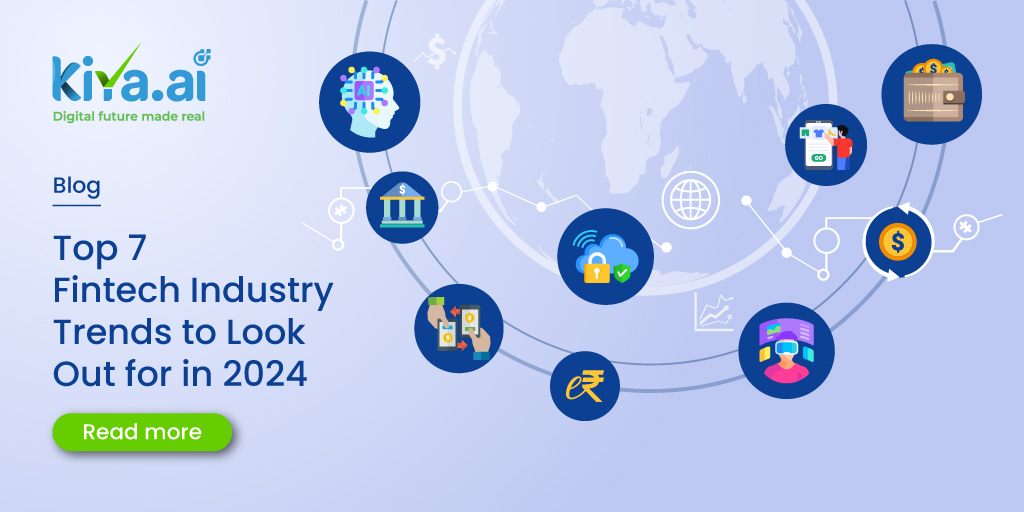Top 7 Fintech Industry Trends to Look Out for in 2024

As we turn the calendar to 2024, the fintech industry anticipates a transformative journey driven by cutting-edge technologies. This isn’t a routine progression of advancements but a pivotal moment where innovative technologies converge, holding the promise to reshape our engagements with finance, risk management, and the entire banking landscape. From the revolutionary impact of Generative AI to the captivating realms offered by the Metaverse, seven discernible trends emerge, signalling the advent of a fresh era in the financial industry.
Here are the seven trends that will unlock industry growth in 2024.
1. Generative AI: Shaping the Future of Finance
Generative AI, also known as GenAI, enables users to provide an assortment of instructions to generate new content, including text, images, videos, sounds, code, 3D designs, and other media. It is trained using materials and artifacts that are already available online. Generative AI models employ neural networks to recognise patterns in existing data and generate new material. With its support, organisations can generate foundation models from extensive unlabelled data collections, effectively establishing a base for AI systems to accomplish tasks. As Generative AI evolves, its role in fostering financial inclusion is anticipated to expand. Financial institutions, armed with the insights and efficiency gained from this technology, can play a crucial role in expanding financial services to rural communities.
2. Embedded Finance: Redefining Accessibility and Delivery
Embedded finance is the integration of financial offerings such as lending, payment processing, and insurance into the infrastructures of non-financial firms, eliminating the need to reroute to traditional financial institutions. This innovative approach enables organisations in the MSME, B2C, and B2B segments to significantly increase client loyalty, generate revenue from their clientele, and substantially expand their product offerings.
With the right technology and support, organisations around the world can offer users access to a wide range of flexible, easy, and cheaper financial services. They can also offer more financial services on user-friendly terms, benefiting from customised offerings that ultimately improve the customer experience.
3. Central Bank Digital Currency (CBDC): A Game-Changer in Digital Evolution
Central Bank Digital Currency (CBDC) is a digital version of currency notes issued by the central bank. While most central banks throughout the world are considering issuing CBDC, the primary motives for doing so differ per country. For example, India’s motivation for implementing CBDC is to enhance financial inclusion and efficiency, while Sweden focuses on reducing cash usage and enhancing monetary policy effectiveness.
It is safe to say that when the financial industry embraces the CBDC trend, institutions are going to be poised to lead the way to a more digitally empowered and secure future. They can then be prepared to lead the transition towards digital currencies while assuring everyone’s accessibility and safety.
4. Quantum Computing: Unlocking Powerful Advantages
Quantum computing has the potential to alter several elements of banking operations. With its ability to process massive amounts of data quickly, it has the potential to revolutionise transaction processing, allowing banks to manage a large number of transactions at incredible speed and efficiency. Furthermore, quantum computing has the potential to revolutionise risk management by quickly analysing complex risk factors and offering more accurate evaluations. In fraud detection, quantum technology’s enhanced computing capabilities can improve banks’ ability to detect and prevent fraudulent activity in real time, hence strengthening security measures. Given the importance of data analysis in banking, quantum computing’s ability to expedite these processes and provide useful insights is extremely intriguing.

5. Hyper Personalised Banking: Elevating Customer Experiences
Hyper-personalisation refers to a comprehensive and detailed awareness of every client’s requirement, desires, and behaviour. This enables banks to provide customised services and products that are unique to each consumer, leading to a more engaging and rewarding customer experience. In other words, hyper-personalisation is near-real-time communication which incorporates machine learning (ML) and artificial intelligence (AI) to process recent client action, incidents, and real-time alerts. In a nutshell as technology advances and customer expectations change, hyper-personalisation becomes increasingly important for banks to remain competitive in the digital age. Embracing this trend not only improves customer satisfaction rate, but it also promotes long-term loyalty and growth potential. As a result, banks must adapt to this trend and invest in the required technology to secure their future relevance and success in the banking sector.
6. Immersive Technologies: Embracing the Metaverse Revolution
Metaverse is a simulated digital environment that incorporates augmented reality (AR) and virtual reality (VR), enabling users to collaborate, interact, and socialise in dynamic 3D environments. Thanks to metaverse, customers get to engage in a variety of banking operations using immersive digital platforms, from applying for debit/credit cards to seeking loans and cancelling payments, all with a few clicks and their login credentials. The switch to paperless transactions not only accelerates procedures but also has a lower environmental impact. Furthermore, banking in metaverse offers clients with comprehensive product and service information, allowing them to make more informed financial decisions. This digital transformation promotes financial inclusion by breaking down geographical barriers and reaching underprivileged population. With the ability to easily cross-sell and upsell goods, banks can increase revenue growth while improving consumer acceptance. The metaverse’s anytime banking service provides users with round-the-clock access to financial services, responding to their
different demands.

7. Open Banking Adoption: Shaping the Future Financial Landscape
Open banking is a banking practise that allows third-party financial service providers to access customer banking, transaction history, and other financial records from banking and non-banking financial services providers using APIs. This practise enables individuals, financial institutions, and third-party service providers to share accounts and data across organisations. Open banking allows banks to grant third-party service providers access to and control over their clients’ personal and financial data.
Customers typically provide some form of agreement before the bank allows the data access, such as clicking a box on a terms-of-service screen in an online app. Third-party provider APIs can then access the customer’s shared data. To empower the global financial industry and ensure they stay ahead of this transformative wave, Fintech providers are at the forefront, offering advanced Open Banking solutions that not only protect consumer data but also foster trust in the system, enabling banks to navigate the Open Banking landscape with confidence and innovation.
With this it is safe to state that the pages of 2024 promise unparallelled technological advancements, providing insight into a financial landscape where technology serves not only to facilitate transactions but also to engineer distinctive and personalised experiences for all stakeholders. This forward-looking trajectory positions businesses to harness the potential of emerging technologies, ensuring a competitive edge in an era defined by technological innovation and financial evolution.

As we turn the calendar to 2024, the fintech industry anticipates a transformative journey driven by cutting-edge technologies. This isn’t a routine progression of advancements but a pivotal moment where innovative technologies converge, holding the promise to reshape our engagements with finance, risk management, and the entire banking landscape. From the revolutionary impact of Generative AI to the captivating realms offered by the Metaverse, seven discernible trends emerge, signalling the advent of a fresh era in the financial industry.
Here are the seven trends that will unlock industry growth in 2024.
1. Generative AI: Shaping the Future of Finance
Generative AI, also known as GenAI, enables users to provide an assortment of instructions to generate new content, including text, images, videos, sounds, code, 3D designs, and other media. It is trained using materials and artifacts that are already available online. Generative AI models employ neural networks to recognise patterns in existing data and generate new material. With its support, organisations can generate foundation models from extensive unlabelled data collections, effectively establishing a base for AI systems to accomplish tasks. As Generative AI evolves, its role in fostering financial inclusion is anticipated to expand. Financial institutions, armed with the insights and efficiency gained from this technology, can play a crucial role in expanding financial services to rural communities.
2. Embedded Finance: Redefining Accessibility and Delivery
Embedded finance is the integration of financial offerings such as lending, payment processing, and insurance into the infrastructures of non-financial firms, eliminating the need to reroute to traditional financial institutions. This innovative approach enables organisations in the MSME, B2C, and B2B segments to significantly increase client loyalty, generate revenue from their clientele, and substantially expand their product offerings.
With the right technology and support, organisations around the world can offer users access to a wide range of flexible, easy, and cheaper financial services. They can also offer more financial services on user-friendly terms, benefiting from customised offerings that ultimately improve the customer experience.
3. Central Bank Digital Currency (CBDC): A Game-Changer in Digital Evolution
Central Bank Digital Currency (CBDC) is a digital version of currency notes issued by the central bank. While most central banks throughout the world are considering issuing CBDC, the primary motives for doing so differ per country. For example, India’s motivation for implementing CBDC is to enhance financial inclusion and efficiency, while Sweden focuses on reducing cash usage and enhancing monetary policy effectiveness.
It is safe to say that when the financial industry embraces the CBDC trend, institutions are going to be poised to lead the way to a more digitally empowered and secure future. They can then be prepared to lead the transition towards digital currencies while assuring everyone’s accessibility and safety.
4. Quantum Computing: Unlocking Powerful Advantages
Quantum computing has the potential to alter several elements of banking operations. With its ability to process massive amounts of data quickly, it has the potential to revolutionise transaction processing, allowing banks to manage a large number of transactions at incredible speed and efficiency. Furthermore, quantum computing has the potential to revolutionise risk management by quickly analysing complex risk factors and offering more accurate evaluations. In fraud detection, quantum technology’s enhanced computing capabilities can improve banks’ ability to detect and prevent fraudulent activity in real time, hence strengthening security measures. Given the importance of data analysis in banking, quantum computing’s ability to expedite these processes and provide useful insights is extremely intriguing.

5. Hyper Personalised Banking: Elevating Customer Experiences
Hyper-personalisation refers to a comprehensive and detailed awareness of every client’s requirement, desires, and behaviour. This enables banks to provide customised services and products that are unique to each consumer, leading to a more engaging and rewarding customer experience. In other words, hyper-personalisation is near-real-time communication which incorporates machine learning (ML) and artificial intelligence (AI) to process recent client action, incidents, and real-time alerts. In a nutshell as technology advances and customer expectations change, hyper-personalisation becomes increasingly important for banks to remain competitive in the digital age. Embracing this trend not only improves customer satisfaction rate, but it also promotes long-term loyalty and growth potential. As a result, banks must adapt to this trend and invest in the required technology to secure their future relevance and success in the banking sector.
6. Immersive Technologies: Embracing the Metaverse Revolution
Metaverse is a simulated digital environment that incorporates augmented reality (AR) and virtual reality (VR), enabling users to collaborate, interact, and socialise in dynamic 3D environments. Thanks to metaverse, customers get to engage in a variety of banking operations using immersive digital platforms, from applying for debit/credit cards to seeking loans and cancelling payments, all with a few clicks and their login credentials. The switch to paperless transactions not only accelerates procedures but also has a lower environmental impact. Furthermore, banking in metaverse offers clients with comprehensive product and service information, allowing them to make more informed financial decisions. This digital transformation promotes financial inclusion by breaking down geographical barriers and reaching underprivileged population. With the ability to easily cross-sell and upsell goods, banks can increase revenue growth while improving consumer acceptance. The metaverse’s anytime banking service provides users with round-the-clock access to financial services, responding to their
different demands.

7. Open Banking Adoption: Shaping the Future Financial Landscape
Open banking is a banking practise that allows third-party financial service providers to access customer banking, transaction history, and other financial records from banking and non-banking financial services providers using APIs. This practise enables individuals, financial institutions, and third-party service providers to share accounts and data across organisations. Open banking allows banks to grant third-party service providers access to and control over their clients’ personal and financial data.
Customers typically provide some form of agreement before the bank allows the data access, such as clicking a box on a terms-of-service screen in an online app. Third-party provider APIs can then access the customer’s shared data. To empower the global financial industry and ensure they stay ahead of this transformative wave, Fintech providers are at the forefront, offering advanced Open Banking solutions that not only protect consumer data but also foster trust in the system, enabling banks to navigate the Open Banking landscape with confidence and innovation.
With this it is safe to state that the pages of 2024 promise unparallelled technological advancements, providing insight into a financial landscape where technology serves not only to facilitate transactions but also to engineer distinctive and personalised experiences for all stakeholders. This forward-looking trajectory positions businesses to harness the potential of emerging technologies, ensuring a competitive edge in an era defined by technological innovation and financial evolution.
